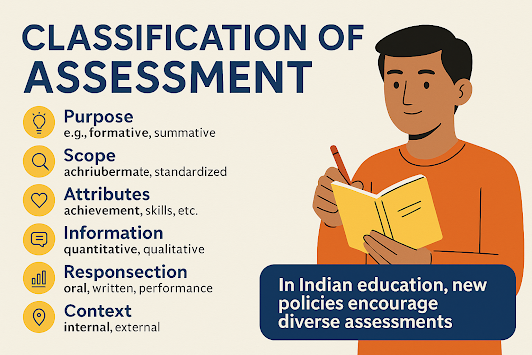Classification of Assessment
(Based on Purpose, Scope, Attributes, Information, Response Mode, Interpretation, and Context)
Introduction
Assessment is the process of collecting information about a learner’s performance, knowledge, attitude, or skills. It helps teachers to understand how much the student has learned and how they can be helped further.
Assessment can be classified in different ways depending on its purpose, scope, attributes, and other factors. In India, education policies like CCE, NEP 2020, and NIPUN Bharat promote various types of assessments for better learning outcomes.
1. Classification Based on Purpose
|
Type |
Meaning |
Example (Indian
context) |
|
Placement |
To decide where to
place a student before starting instruction |
Entry test before
joining a tuition class |
|
Formative |
Done during
teaching to improve learning |
Class test
after every lesson |
|
Diagnostic |
To identify learning
problems and reasons |
Test to find out why a
child is weak in reading |
|
Summative |
Done at the
end of a course to assign marks or grades |
Final school
exam or board exam |
2. Classification Based on Scope
|
Type |
Meaning
|
Example |
|
Teacher-made Test |
Prepared by individual
teachers for their own class |
Weekly school test
made by a teacher |
|
Standardized Test |
Prepared by
experts, same for all students, tested before use |
CBSE Board Exam,
NTSE |
3. Classification Based on Attributes Measured
|
Type |
What it Measures |
Example |
|
Achievement |
Measures what has been learned |
Chapter-wise school test |
|
Attitude |
Measures feelings, opinions, or values |
Survey on students’ interest in science |
|
Aptitude |
Measures future potential or
ability |
Olympiad, Talent Search Test |
|
Skills |
Measures specific skills (like
reading) Performance in a drawing or lab activity |
|
4. Classification Based on Nature of Information
|
Type |
Meaning |
Example |
|
Quantitative |
Based on numbers and
scores |
8 out of 10 in a test |
|
Qualitative |
Based on
description, observation, and behavior |
Remarks on
student behavior in class |
Indian Concept Example:
In CCE (Continuous and Comprehensive Evaluation), both marks (quantitative) and teacher comments (qualitative) were used.
5. Classification Based on Mode of Response
|
Type |
Meaning |
Example |
|
Oral |
Student answers by
speaking |
Oral quiz or viva |
|
Written |
Student
writes the answer |
Written test
or assignment |
|
Performance-based |
Student performs a
task |
Science experiment,
art display |
6. Classification Based on Nature of Interpretation
|
Type |
Meaning |
Example |
|
Norm-referenced |
Compares student
performance with others |
Ranking students in
class |
|
Criterion-referenced |
Compares
performance to a fixed standard or learning goal |
Giving grade
based on 80% score (not comparing with others) |
Indian Example:
Norm-referenced: Class rank in board exam
Criterion-referenced: “Passed” if scored 33%, as per board rules
7. Classification Based on Context
|
Type |
Meaning |
Example |
|
Internal |
Conducted by the school or teacher
|
Class tests, school-level exams |
|
External |
Conducted by external agencies |
Board
exams (CBSE, BSE Odisha), NEET |
Indian Example:
Internal: Teacher's own assessment in school
External: Class 10 BSE Odisha board examination
Conclusion
Assessment is not one-size-fits-all. Depending on the goal, context, and learner's need, different types of assessments are used. In India, new educational policies are encouraging continuous, flexible, child-friendly assessments to ensure better learning for all students.
Right type of assessment helps both teaching and learning grow together.




No comments:
Post a Comment